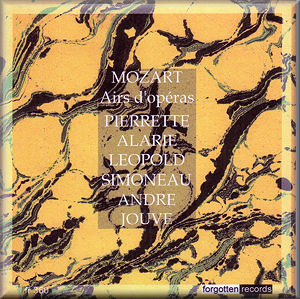 |
 |
|

Availability
CD: Forgotten
Records |
Wolfgang Amadeus MOZART (1756–1791)
Opera Arias
Le nozze di Figaro, K 492
1. Voi che sapete [2:53]
2. Non so piu [2:37]
Concert Aria, K 316
3. Popoli di Tessaglia [12:25]
Die Entführung aus dem Serail, K 384
4. Welche Wonne [2:46]
Il Ré pastore, K 208
5. L’amero sarò costante [6:48]
Die Zauberflöte, K620
6. O zittre nicht [4:57]
7. Der Hölle Rache [2:45]
La clemenza di Tito, K 621
8. Se all’impero [5:14]
Die Zauberflöte, K 620
9. Dies Bildnis [4:08]
Concert Aria, K 431
10. Misero! O sogno, o son desto? [9:42]
Die Entführung aus dem Serail, K 384
11. Ich baue ganz [6:23]
12. Konstanze, dich wiederzusehen … O wie ängstlich [5:15]
Idomeneo, K 366
13. Torna la pace [6:26]
 Pierrette Alarie (soprano) (1–7), Leopold Simoneau (tenor) (8–13)
Pierrette Alarie (soprano) (1–7), Leopold Simoneau (tenor) (8–13)
Orchestre du Théâtre des Champs-Elysées/André Jouve
rec. Salle Apollo, Paris, 2 May 1955 (8–13) and 9 May 1955 (1–7)
No texts or translations.
 FORGOTTEN RECORDS FR 360 [72:26]
FORGOTTEN RECORDS FR 360 [72:26] 
|
|
|
The French-Canadian couple Leopold Simoneau (1916–2006) and
Pierrette Alarie (b. 1921) met in the early 1940s in Montréal
and married in 1946. In 1949 they left for France where their
careers blossomed, primarily in Mozart and in French repertoire.
They sang at all the major festivals and visited Vienna and
Munich. They also sang extensively in North America. This disc
is compiled from two solo recitals, recorded one week apart,
and finds both singers at the peak. They continued singing until
1970, and after that taught other aspiring singers in Canada.
They both left a rather large legacy of recordings, together
but also individually. They had a special affinity for Mozart
and all lovers of elegant stylish Mozart singing should lend
an ear to this disc. Sonically it isn’t much to write home about:
the orchestra is quite undistinguished but it doesn’t let the
whole thing down and the voices are recorded with admirable
clarity.
Cherubino’s arias from Le nozze di Figaro are lively,
nervous and youthful, the seventeen-year-old skirt-chaser being
portrayed as the butterfly Figaro calls him in his aria Non
più andrai. There is also a great deal of restrained wonder
in the slow section of Non so più.
The concert aria Popoli di Tessaglia, an insert aria
for Gluck’s Alceste, is among the longest of its kind
with an extended orchestral interlude between the slow recitative
opening and the aria proper. The demands on the singer are enormous
and Alarie impresses through her technical command, the sheer
beauty of the voice and her expressivity. This is as challenging
as the Queen of the Night’s arias, requiring the singer to toss
off a high G - a step higher than the Queen’s top note. No wonder
that it is so rarely heard. It was written for Aloysia Weber
who was only 18 at the time.
Blonde’s Welche Wonne is a rousing portrayal of the young
and energetic girl who has a mind of her own. The aria from
Il Ré pastore is one of the gems in Mozart’s production.
It is in effect a duet between Aminta and a solo violin, which
unfortunately is rather wiry in this recording. Ms Alarie, however,
sings with excellent legato and warm tone.
Finally we get the Queen of the Night’s arias – too heavy fare,
one would think, for the ultra-lyrical Alarie, but she displays
surprising power and formidable technique. She also seems to
apply harder tone to depict the evil nature of the Queen.
Leopold Simoneau recorded several of his arias as part of the
complete operas he took part in during this period. His slightly
veiled tone is not unlike Tito Schipa’s and he sings with the
same elegance and the same natural phrasing. Dies Bildnis
is even milder than the one he sang for Karl Böhm’s Decca recording
the same year. He recorded the concert aria Misero! O sogno
for Concert Hall a few years later and it was through that record
I learnt the aria. He had more power then but also some more
strain. Both are stylistically ideal.
Beecham’s recording of Die Entführung aus dem Serail
is a classic, not least for the participation of Gottlob Frick
and Leopold Simoneau. Maybe the latter was more inspired by
Beecham’s insightful conducting than he was a year earlier in
Paris but O wie ängstlich is sung with that combination
of honeyed tone and eager edge that makes his voice so characteristic
and so eminently suitable for Mozart. Ich baue ganz,
technically a stumbling-block for many tenors, is also as close
to the ideal as it is possible to come. If I remember correctly
it wasn’t included in the Beecham set.
Simoneau also took part in a recording of Idomeneo in
1956 under John Pritchard but there he was a marvellous Idamante
– Richard Lewis sang the title role – so it is good to have
an example of his Idomeneo as the concluding number. Though
not a very strong-voiced singer he knew how to project the tone
and actually make it seem larger than it was.
I can only repeat my verdict at the opening of this review:
‘… all lovers of elegant stylish Mozart singing should lend
an ear to this disc.’
Göran Forsling
|
|

